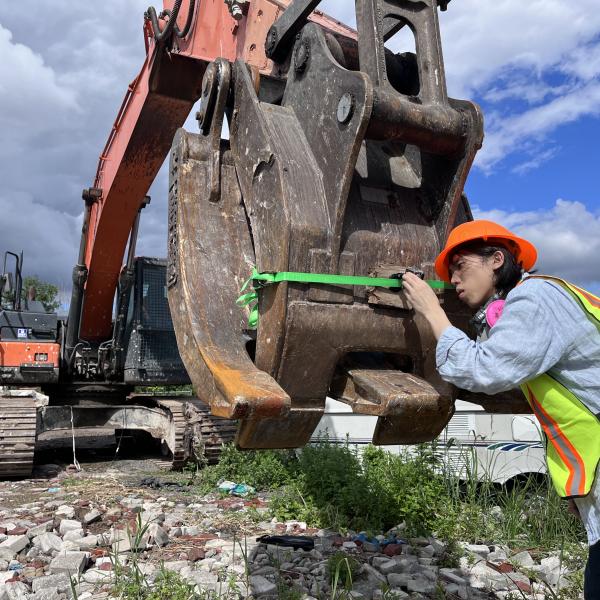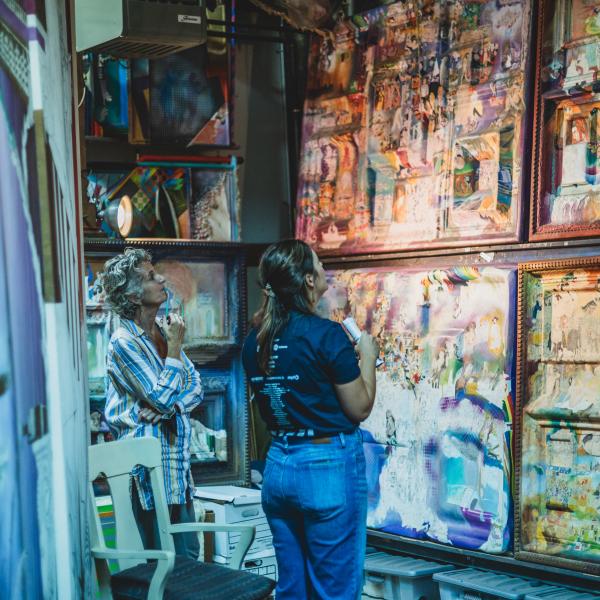A Welcoming Hub of Musical Activity for All Arkansans

Christina Littlejohn speaking at the Topping-Out ceremony for the new Stella Boyle Smith Music Center. Photo by Nelson Chenault
Long before I came to the National Endowment for the Arts, I met Christina Littlejohn, the CEO of the Arkansas Symphony Orchestra (ASO), during an intensive professional development opportunity for arts organization leaders. It didn’t take long for me to recognize her warmth and kindness, her passion for the arts, and her wicked-smart intellect. Since then, I’ve kept my eye on her work at the ASO, which is a frequent NEA grantee.
The 58-year-old orchestra has never had its own permanent home, but that will no longer be the case when they open the new Stella Boyle Smith Music Center this September. Named after a woman who helped start the orchestra in her home years ago, the center will also have specific spaces named for other individuals who made sure that the organization continued to thrive over the last few decades. In this way, the new space will honor the past at the same time that it meets current community needs, with an eye toward future generations of Arkansans as well.
I recently spoke with Littlejohn to learn about this exciting $11.75 million endeavor that will be located in the East Village of Little Rock, an area that has been historically overlooked and underutilized. What follows is the story of the project’s evolution in her own words.
THE SPARK THAT IGNITED THE PROJECT
With just one rehearsal hall in a building over 100 years old, we struggled to accommodate our three youth ensembles and staff. We made it work by using the storage room and even having rehearsals outdoors sometimes. One day, I’m looking out the window at a violin sectional rehearsing on the lawn when the sky suddenly opened up and the rain came pouring down. These poor kids, struggling to protect their instruments, came running inside. I knew we had to do better for these young musicians, especially since we had added a popular string academy to teach kids violin and cello. It was awesome to see the demand for the classes, but it was also clear we had to have more space. It was especially important to our music director, Geoffrey Robson, and the directors of our youth programs that we offer a professionally equipped space that shows them they are valued and that their musical creativity matters.

Student cellist Adrian Mayora, inside of the Arkansas Symphony Orchestra storage room, practicing in advance of his audition for the youth orchestra. Photo by Kelly Hicks
A SPACE REIMAGINED
The Arkansas Symphony Orchestra will continue to perform in the previously established Robinson Performance Hall [a rental hall], which can accommodate an audience of 2,200. The new music center is more of a community space with six practice rooms for private lessons; group lessons and rehearsals; as well as a 300-seat performance hall, Morgan Hall, which will accommodate concerts by small ensembles, such as a string quartet and piano and rehearsals of the youth ensembles and the ASO community orchestra, comprised primarily of amateur adults.
One player in the community orchestra was 104 years old when she had to quit because she couldn’t carry her cello up the stairs to rehearsals anymore. The new space will be accessible to people of all ages and to those who need accommodations, so maybe she will be able to rejoin the group. We’ll also have a catering kitchen so we can do events there, such as lunchtime concerts, and will be able to experiment with more ways to reach our community.
The music center will include a broadcast recording studio, which we realized we needed during the pandemic when we started broadcasting the Bedtime with Bach series that reached over a million people from 30 different countries. The facility will also allow us to record programs that schools can use for their music programs. Students can even use the recording studio to make their college and music camp audition recordings.
As the Arkansas Symphony Orchestra, we are very excited about the endless possibilities of the broadcast/recording studio to serve the entire state. Members of the youth orchestra come from 33 different communities to play with us, and our professional musicians currently travel the four corners of the state to perform for schools. The broadcast studio will help us reach thousands of kids and adults in counties that can’t easily get to Little Rock.
THE ROLE OF COMMUNITY STAKEHOLDERS
Our music director was previously our youth orchestra director, so he knows firsthand the impact of the youth orchestras and our programs for youth. To him, raising the funds and creating this building through the pandemic shows teamwork, discipline, and resilience, and those are the very same qualities that we help the members of our youth orchestras develop. In addition to the music director, our orchestra musicians—many of whom are also teachers—have had a role in envisioning the new facility.
In 2023, we created a community task force with representatives from the Central Arkansas Library System, City of Little Rock, University of Arkansas for Medical Sciences, Blue Cross Blue Shield, [William J.] Clinton Presidential Library, and others, including the pastor of worship and arts at Saint Mark Baptist Church, Darius Nelson. The task force helped us be thoughtful about how to ensure this music center is truly the community's music center. It's easy for the musicians, Geoff, and me to think about how we're going to use the building, but that's not ultimately who it's for—it's really for the betterment and enrichment of our community.
The community task force came up with an aspirational goal that has become a guiding principle for the Music Center: To be a radically welcoming hub of musical activity for all Arkansans. During one meeting of the task force, Pastor Nelson said, “I want to know that I belong there the minute I walk in. I want to see myself there.” That was really important for us to hear.
We plan to accomplish this in many ways. The center has lots of glass, so when you're outside you'll be able to see the musicmaking as it happens, and when you’re inside you feel part of the community. The signage will be in Spanish, English, and Braille, and signage around the piano in the lobby will say, “Play Me.” Even the furniture will help convey a warm welcome, with big beanbag chairs so the kids can feel comfortable and with a lot of spaces where they can plug in their computers.
We’ll also have several digital signboards that can help us tell stories for and about our community. For example, we will share information about significant Arkansan composers Florence Price and William Grant Still, who both studied with the same music teacher here in Little Rock. There is a huge tradition of Ozark folk music in the area and others’ stories that we want to share. And let’s not forget Johnny Cash, whose statue is now in the U.S. Capitol.

Architectural rendering of the new Stella Boyle Smith Music Center. Photo courtesy of WER Architects
UNVEILING THE NEW MUSIC CENTER
We want it to reflect our goal of being a radically welcoming musical hub for all Arkansans, and we mean to include all kinds of music. In addition to the official ribbon cutting along with fanfares by brass players, the opening will include a wide variety of music by our community, including performances by members of the youth and community orchestras, fiddlers from the Ozark folk tradition, the Saint Mark Baptist choir and jazz ensemble, and members of our professional orchestra. We’re planning an on-site Beethoven Five play-along with alumni of the youth orchestra joining via Zoom. There will also be a parade including drumlines from local high schools, circus artists on stilts, a dragon or two from our Chinese community, and we’re hoping for puppetry from the Mexican community, as well as other offerings from all around the state.
THE POWER OF COMMUNITY VOICES
Looking back at our progress so far, the decision to put together a strong community task force seems key. Including the community and making sure you listen to their voices is essential if you want people to embrace the new facility and consider it home.
Pastor Nelson, who sadly just passed away quite unexpectedly, had many high-profile successes in his career and he did a number of amazing things. But [in a recent phone call], his wife told me that the thing he was most excited to talk about was working with the Arkansas Symphony on this project. When you invite the community to contribute their ideas and ask for their help, the result is an inclusive, welcoming space for everyone. The contributions of the task force have been an incredible gift to our institution.








